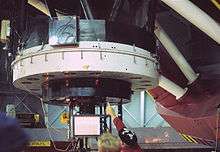Bernard Lyot
Bernard Ferdinand Lyot (27 February 1897, in Paris – 2 April 1952, in Cairo) was a French astronomer.
Bernard Lyot | |
|---|---|
| Born | February 27, 1897 Paris, France |
| Died | April 2, 1952 (aged 55) Cairo, Egypt |
| Nationality | French |
| Citizenship | France |
| Alma mater | University of Paris |
| Known for | Solar astronomy |
| Awards | Gold Medal of the Royal Astronomical Society |
| Scientific career | |
| Fields | Astronomy |
Biography
An avid reader of the works of Camille Flammarion, he became a member of the Société Astronomique de France in 1915 and made his first observations using the society's telescope on rue Serpente in Paris.[1] He soon acquired a 4-inch (100 mm) telescope and soon upgraded to a 6-inch (150 mm). From graduation in 1918 until 1929, he worked as a demonstrator at the École Polytechnique and studied engineering, physics, and chemistry at the University of Paris.
From 1920 until his death he worked for the Meudon Observatory, where in 1930 he earned the title of Joint Astronomer of the Observatory. After gaining the title, he earned a reputation of being an expert of polarized and monochromatic light. Throughout the 1930s, he labored to perfect the coronagraph, which he invented to observe the corona without having to wait for a solar eclipse. In 1938, he showed a movie of the corona in action to the International Astronomical Union. In 1939, he was elected to the French Academy of Sciences. He became Chief Astronomer at the Meudon Observatory in 1943 and received the Bruce Medal in 1947.
Lyot was the President of the Société astronomique de France, the French astronomical society, from 1945-1947.[2]
He suffered a heart attack while returning from an eclipse expedition in Sudan and died on 2 April 1952, at the age of 55.
Observations and Achievements on Pic du Midi
- Lunar soil behaves like volcanic dust.
- Mars has sandstorms.
- Improved his coronagraph.
- Made motion pictures of solar prominences and the corona.
- Found spectral lines in the corona.
Awards and honors
Awards
- Lalande Prize from the French Academy of Sciences[3]
- Janssen Medal from the French Academy of Sciences (1930)
- Prix Jules Janssen, the highest award of the Société astronomique de France(1932)
- Gold Medal of the Royal Astronomical Society (1939)[4]
- Howard N. Potts Medal (1942)[5]
- Bruce Medal (1947)[6]
- Henry Draper Medal of the National Academy of Sciences (1951)[7]
Named for him
- Lyot (lunar crater).
- Lyot (Martian crater).
- Minor planet 2452 Lyot.
References
- D'Azambuja, L. "L'œuvre de BERNARD LYOT," L'Astronomie, Vol. 66, p.266.
- List of presidents of the Société astronomique de France
- "The Bruce Medalists". Retrieved 18 December 2014.
- "Winners of the Gold Medal of the Royal Astronomical Society". Royal Astronomical Society. Archived from the original on 25 May 2011. Retrieved 24 February 2011.
- "The Bruce Medalists". Retrieved 18 December 2014.
- "Past Winners of the Catherine Wolfe Bruce Gold Medal". Astronomical Society of the Pacific. Archived from the original on 21 July 2011. Retrieved 24 February 2011.
- "Henry Draper Medal". National Academy of Sciences. Archived from the original on 26 January 2013. Retrieved 24 February 2011.
